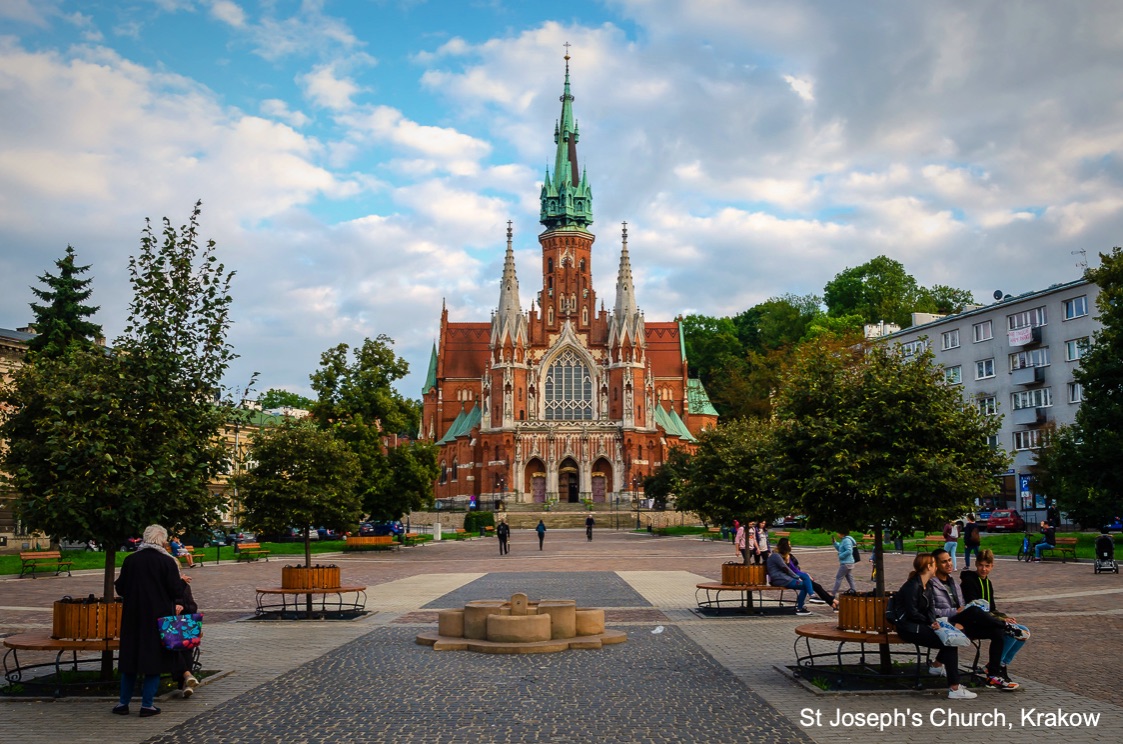Kraków is the most beautiful and alluring city in Poland. It was once the seat of the Polish Kings and escaped WWII with minimal damage. As a result, medieval streets, buildings and monuments are intact and surrounded by bars, pubs, clubs and restaurants. It has world-class museums and many universities, providing a rich cultural environment amidst a college-town atmosphere.
While Polish people are quite aware of the city’s appeal and visit in huge numbers, foreign visitors are relatively few for such an incredible place. Most non-Europeans have little idea of the city’s treasures and lively atmosphere. This is changing but everyone should see Kraków with their own eyes!
Where is Kraków?
Kraków is located in the south-central part of Poland and is close to other great cities of Central Europe. It’s only 240km/150mi from Budapest, 300km/180mi from Warsaw, 330km/205mi from Prague and 460km/285mi from Vienna.
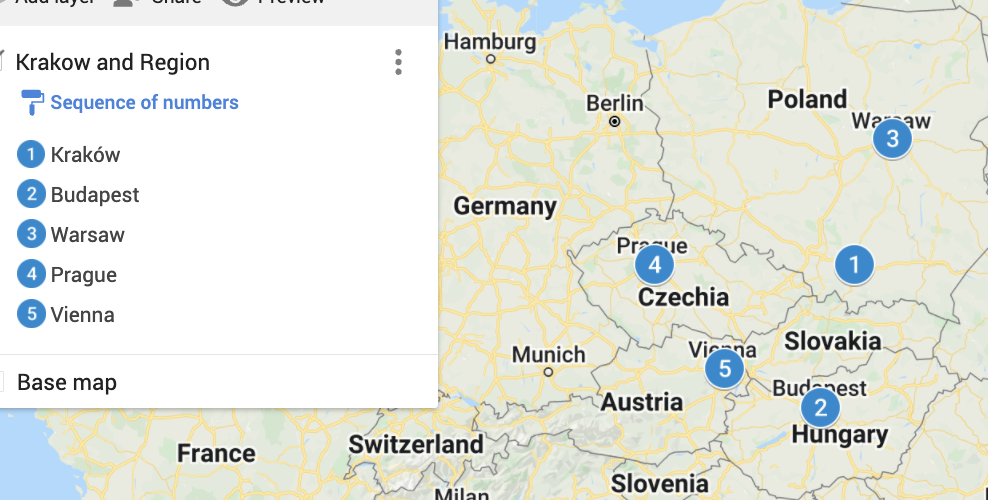
Kraków has direct train and highway connections with all of these places.
Why We Went to Kraków
In August and September 2021, my wife Khadija and I went on a five-week drive through Eastern Europe and visited many of the great cities of the region. We definitely wanted to go to Kraków and spent four days there.
Is Kraków Safe?
Kraków is very safe and may be more so than other major cities in Poland. Here, as everywhere you travel, employ basic safety precautions and use common sense to avoid problems..
Is Kraków Expensive?
In comparison to other major European cities, Kraków is less expensive. As Poland’s currency is the Złoty (the Polish letter Ł, aka L-with-a-stroke, sounds the same as W) and not the Euro (which inevitably brings higher prices).
Where to Stay in Kraków
Most attractions are in the Old Town (Stare Miasto) and the adjacent Kazimierz (Jewish Quarter), so it makes sense to stay in one of these two sections.
We stayed in the boutique Hotel Indigo – Kraków Old Town, which occupies an interestingly renovated, old building and has a small gym (a big plus for me).
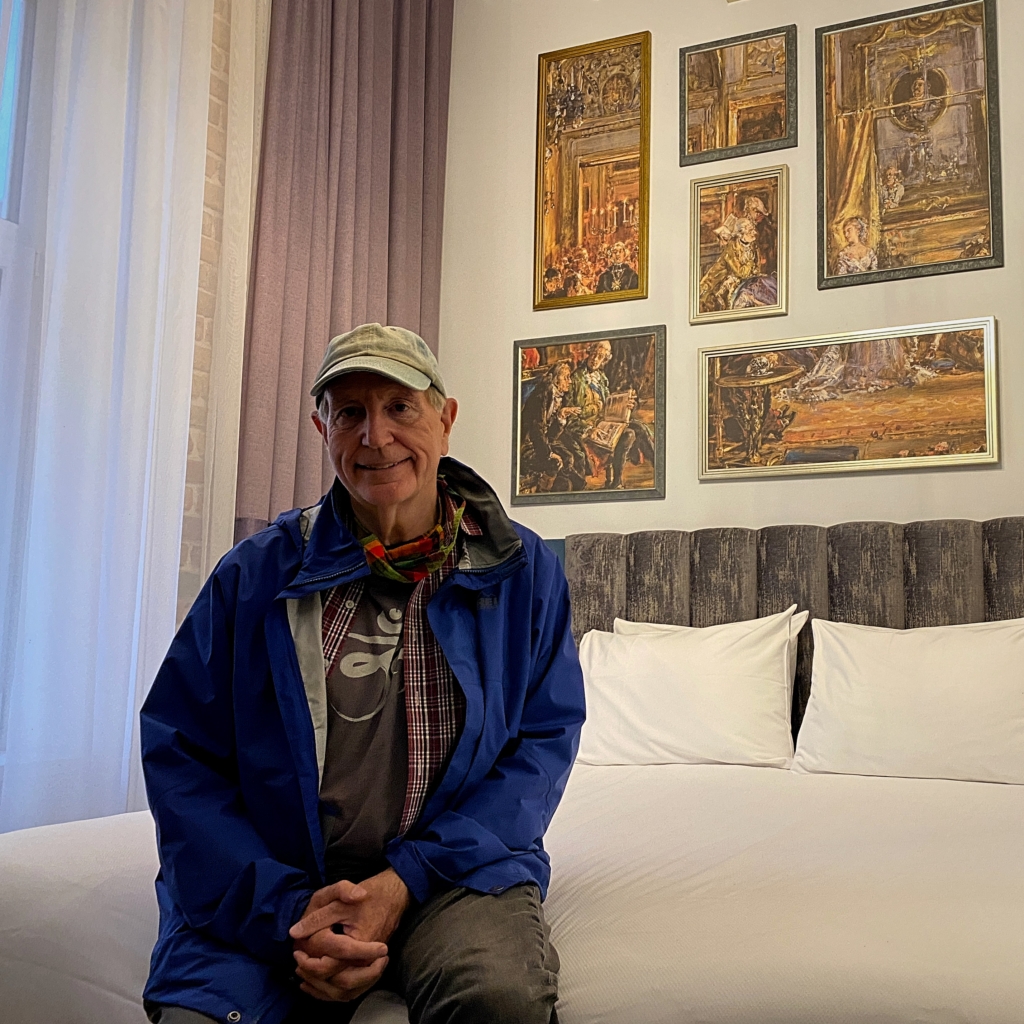
It’s a five minute walk to the Barbican, which is a good place to start your visit to the Old Town. There are several restaurants nearby, as well as a tram station for several lines.
How to Get Around Kraków
Here’s a map of some of Kraków sites worth visiting. Be aware this post only mentions some of our favorites and there are far too many to include.
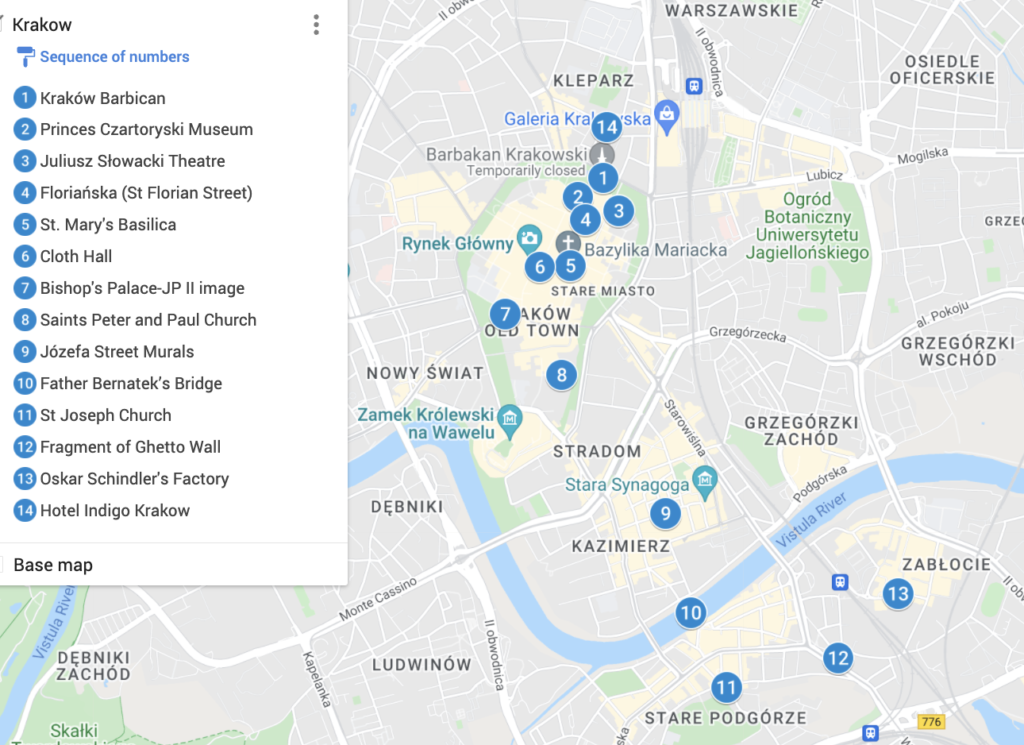
The center of Old Town, where most attractions are, is pedestrian only. Kazimierz (Jewish Quarter) and the parts of Podógrze of interest are within a 30-minute walk.
The tram is a good alternative. You can get a 20-minute tram ticket for just 2.8 Złoty (about US$0.65) for Zone 1 which is for the city. Zone 2 is for locations outside of the city which few tourists go to. There are longer periods for single rides, as well as 24-hour, 48-hour, 72-hour and 7-day cards. Preschool children, adults 70 years or older and people with disabilities can ride for free. You can buy tickets at the stations.
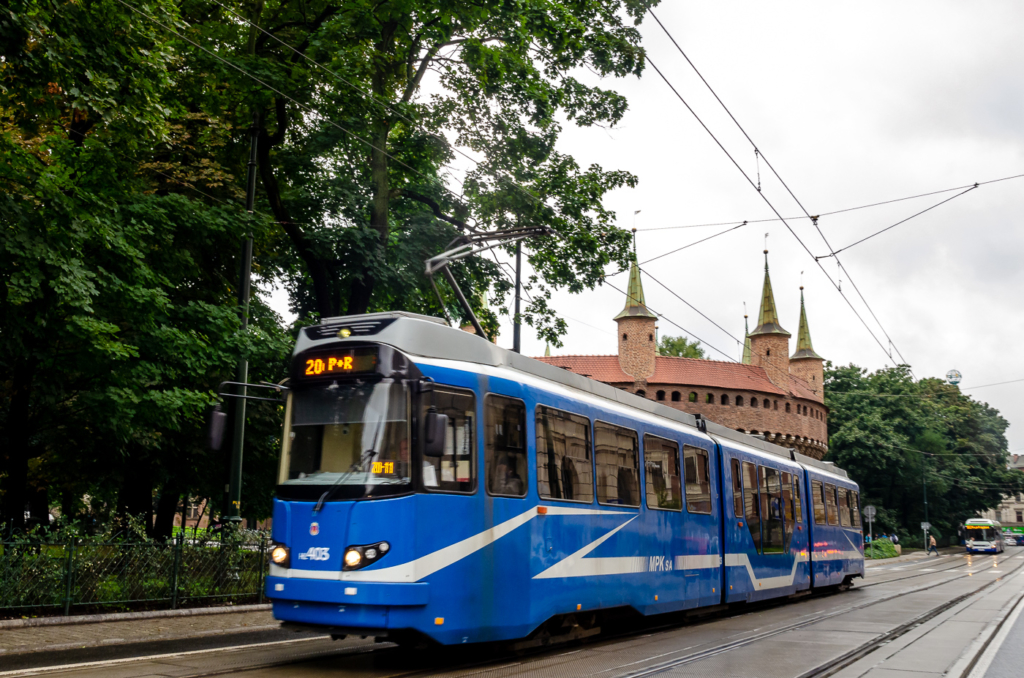
Kraków traffic is congested and not fun to drive in. Our car remained parked except when we went to the Wieliczka Salt Mine. You can take a bus there which includes the admission ticket.
Kraków has many free walking tours (tips expected) in English. We took two from Kraków City Tours, one of the Old Town and another to the Jewish Quarters with our informative guide Magda.
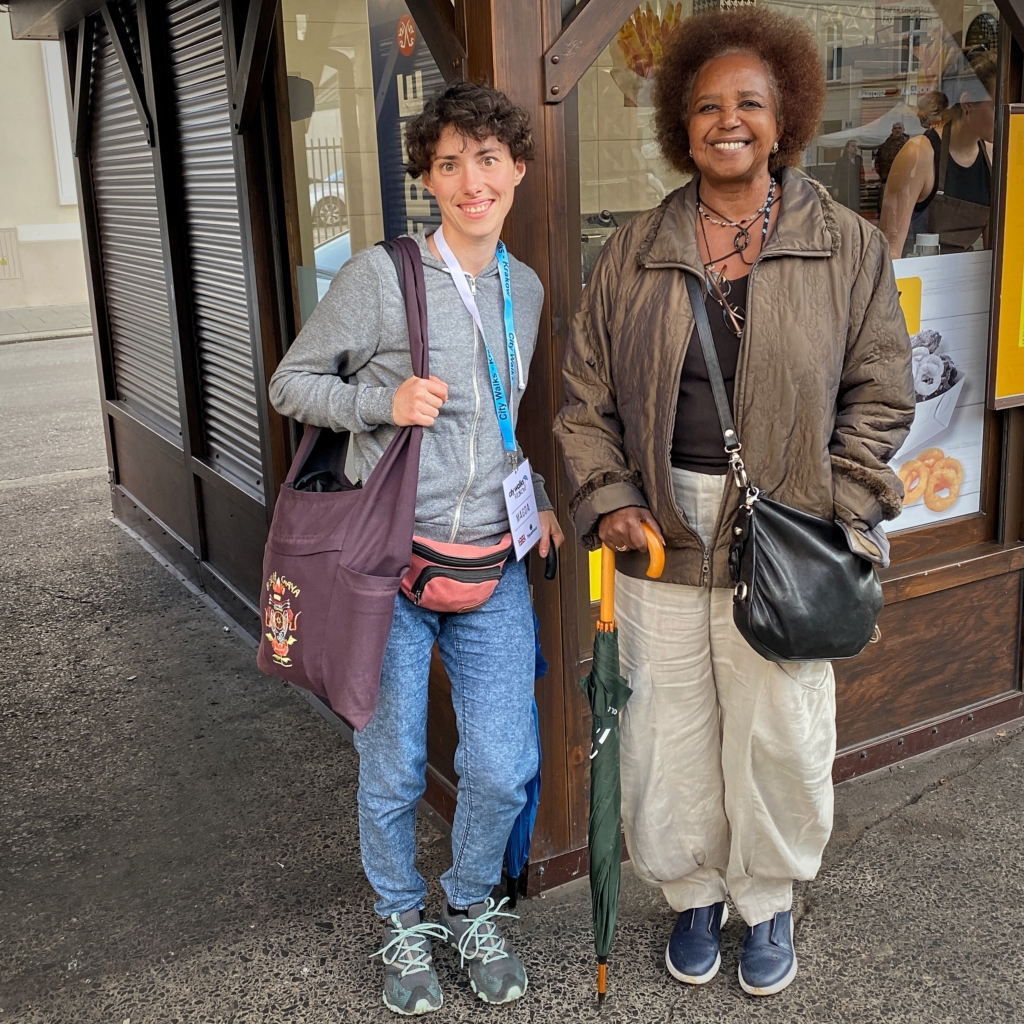
It rained most of the time we were there but it didn’t distract us and provided some interesting images.
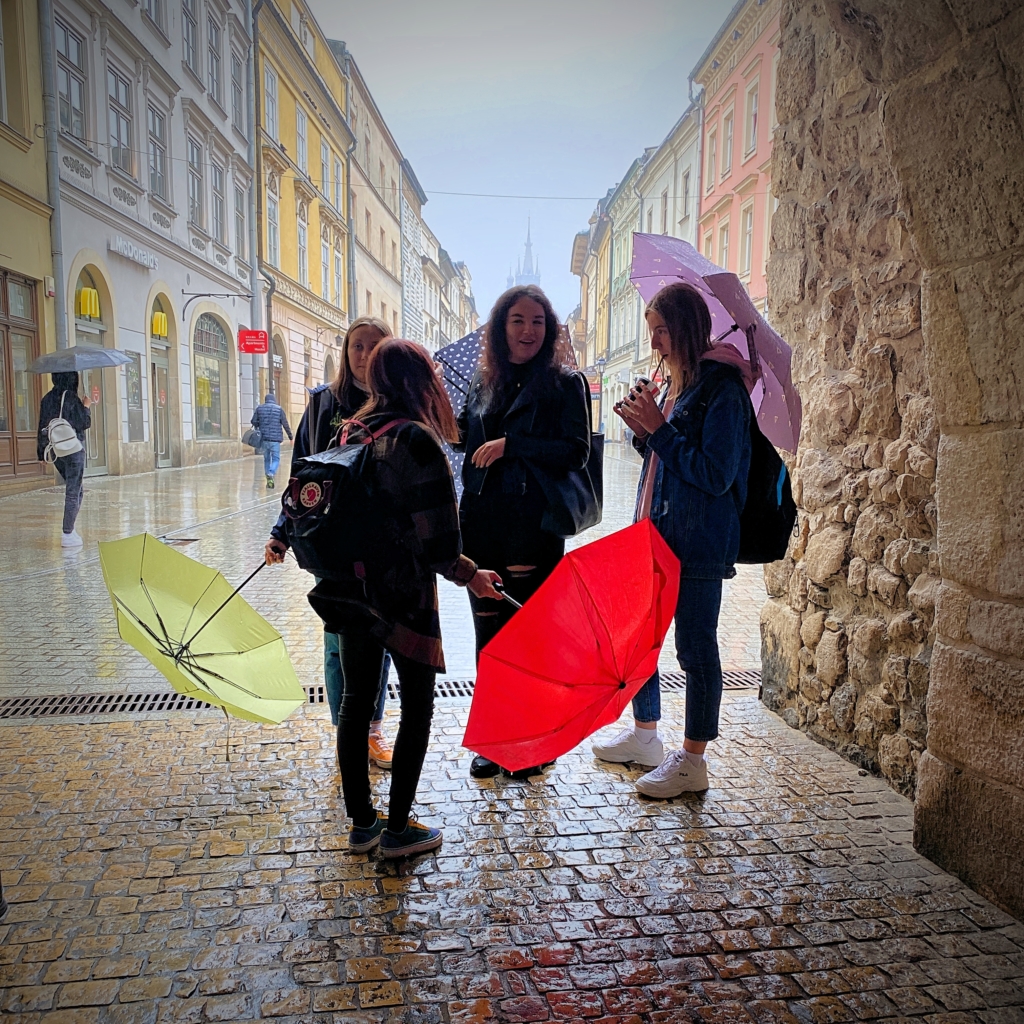
Where to Eat in Kraków
There’s no shortage of excellent restaurants in Kraków. We enjoyed a very good, traditional Polish meal at the warmly decorated and quiet Jarema, close to the Barbican. Our waiter Daniel, who was studying languages and spoke good English, relayed considerable information on Polish culture.
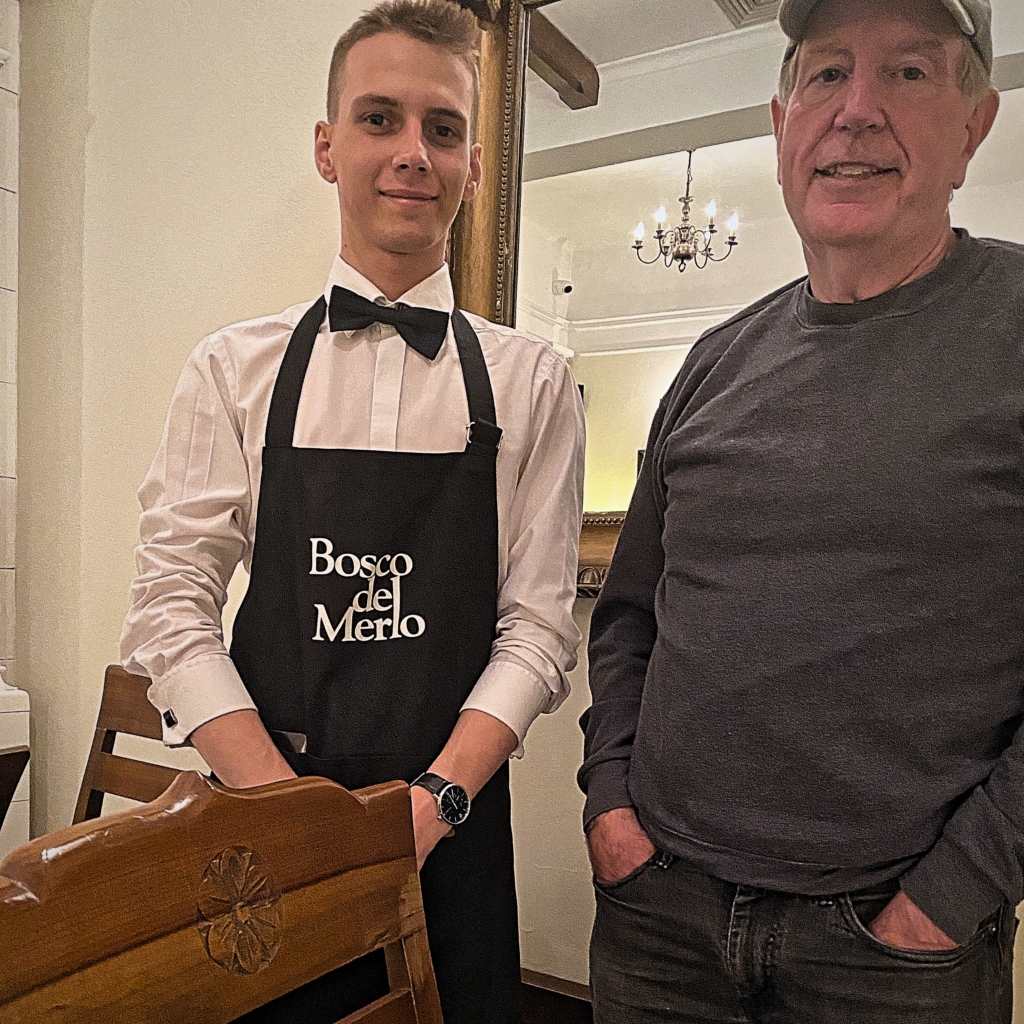
Two others worth noting: Gruzińskie Chaczapuri in the Old Town, serving Georgian cuisine and in Kazimierz, the cozy, eclectically-furnished Moment Resto Bar offering meals and drinks all through the day.
Old Town (Stare Miasto)
The center of Old Town is encircled by Planty Park, which has interesting memorials and art pieces, such as the Statue of Jan Matejko in a rectangle.
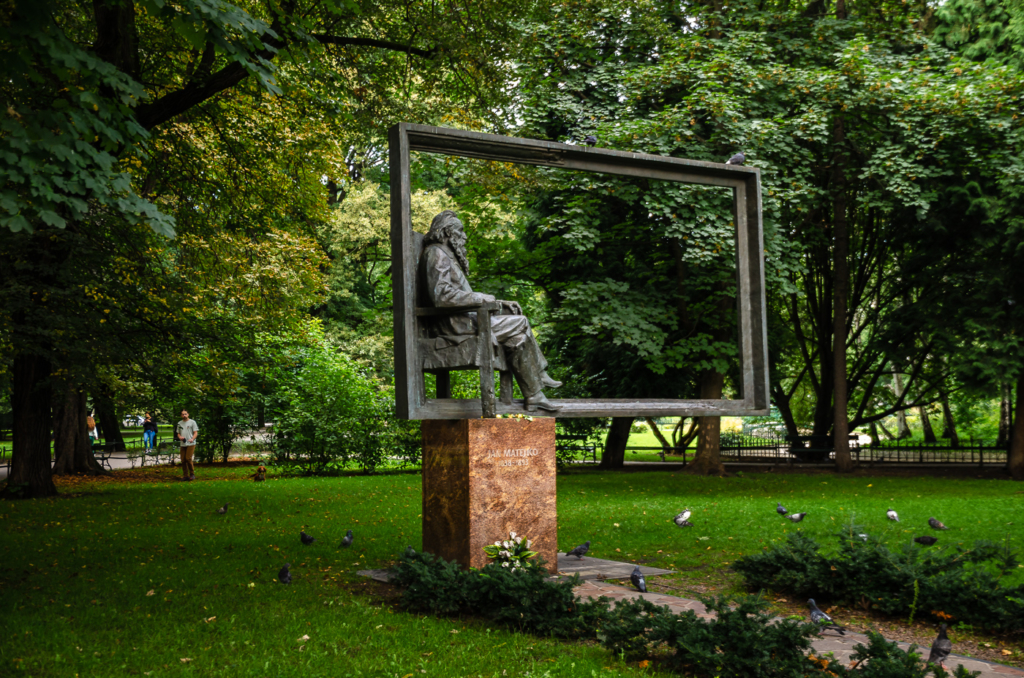
Market Square (Rynek)
In the center of the Old Town is Europe’s largest market square, the size of nine American-football fields, with Cloth Hall (Sukiennice) dating from the 14th century

Inside there are numerous sellers and traders of crafts and souvenirs.
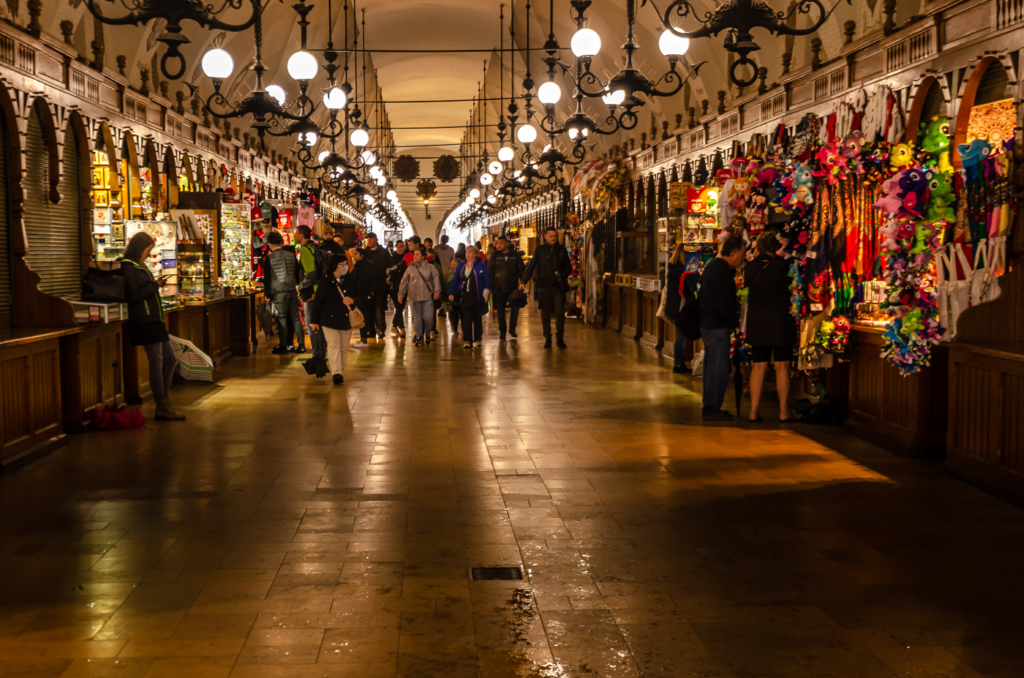
Many stalls sell amber stones and jewelry, a legacy of Kraków being on a busy trade route with the Baltic Sea, where sea amber is mined. Under the building is a dimly lit museum of excavated medieval merchant stalls and exhibits on the city’s history. It’s certainly worth spending an hour here.
Perhaps the most striking building in the Old Town is St. Mary’s Basilica. The foundation was constructed in the 13th century and the initial church was built in the next century. It has been expanded and modified ever since and the two-tower church is a UNESCO World Heritage Site
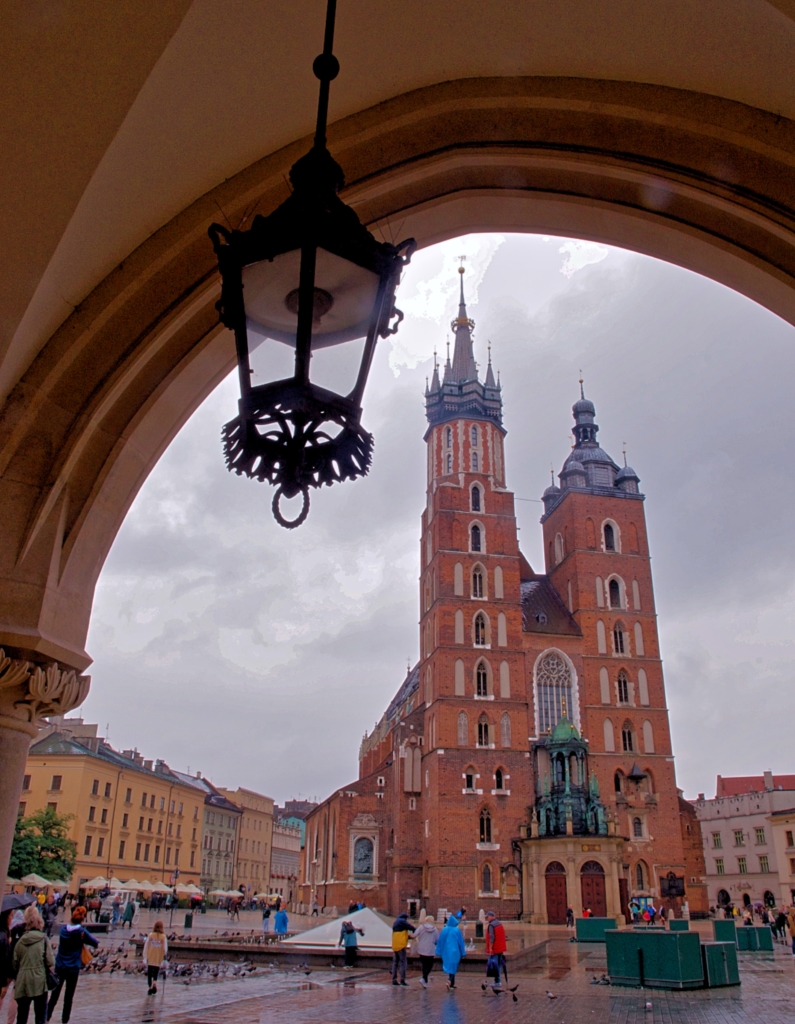
The interior is magnificent and the Gothic triptych altarpiece carved from linden wood is considered a Polish treasure.
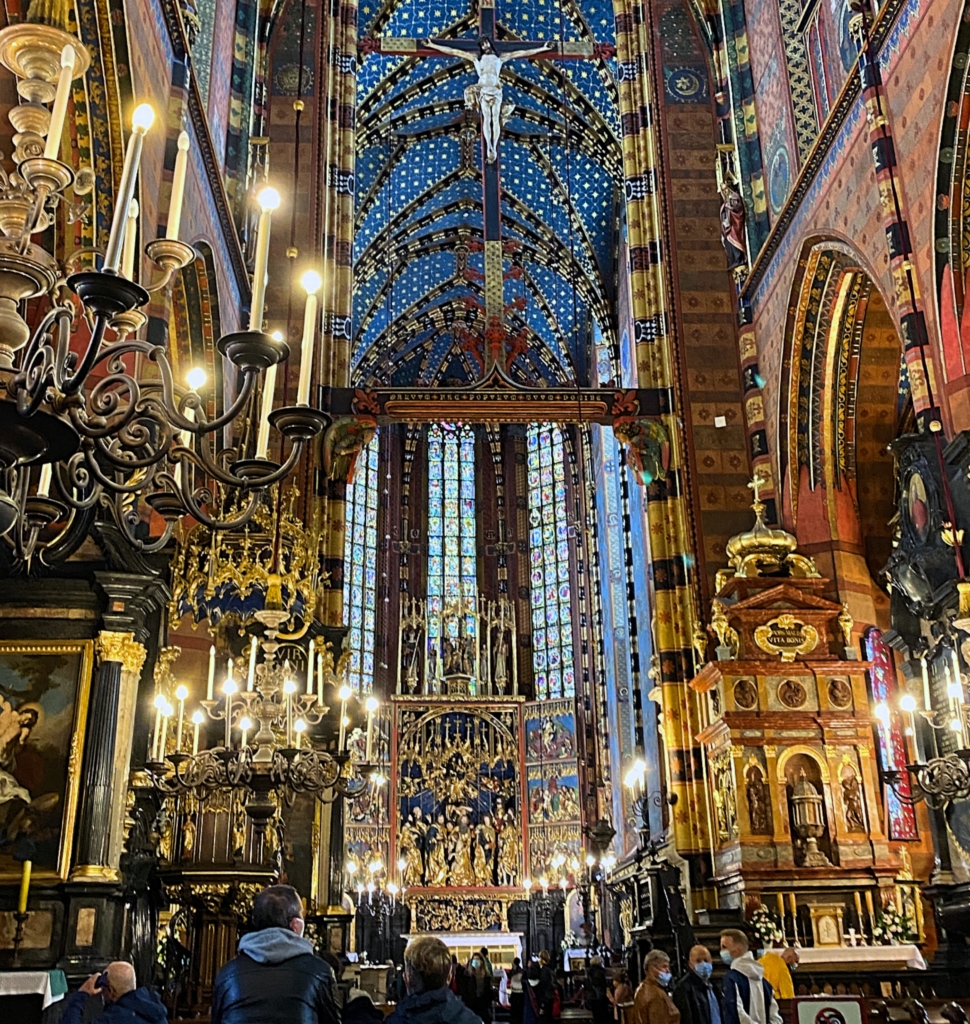
On every hour, a trumpet is played from the tallest towers and stops in mid-stream, to commemorate a 13th century trumpeter who was shot while sounding the alarm before a Mongol attack on the city.
Princes Czartoryski Museum
The Princes Czartoryski Museum has a superlative collection of paintings by European masters and numerous items from Polish history. The museum’s highlight and pride of Kraków is Leonardo da Vinci’s Lady with an Ermine, one of his only four female portraits (one being Mona Lisa).
I liked this amazingly decorated clock.
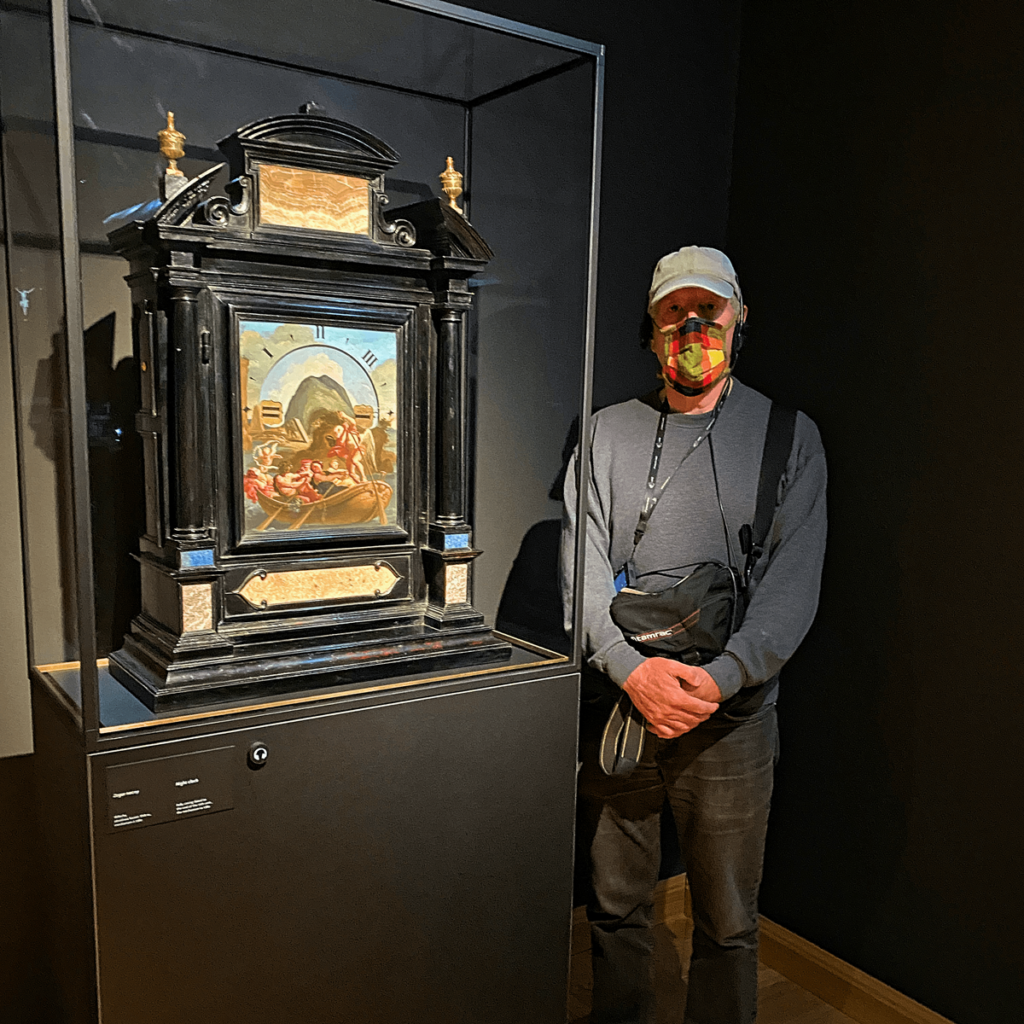
Saints Peter and Paul Church
Even in a city with so many splendid churches, this Baroque, white marble one stands out. It was built during the Counter-Reformation fervor of the 16th Century. The twelve apostle statues in front of the prominent metalwork were actually added in the 18th century.
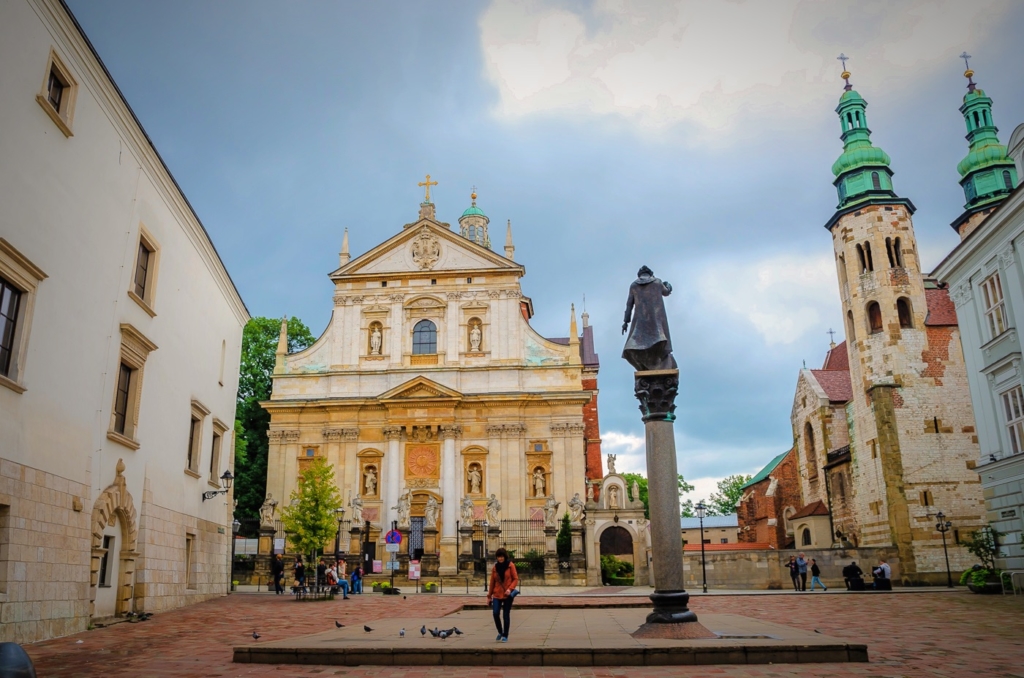
Wawel Royal Castle
This extremely important castle in Polish history is a complex of buildings with fabulous artistic and heritage collections. The castle derives its name from the Wawel limestone hill and borders the Vistula River.
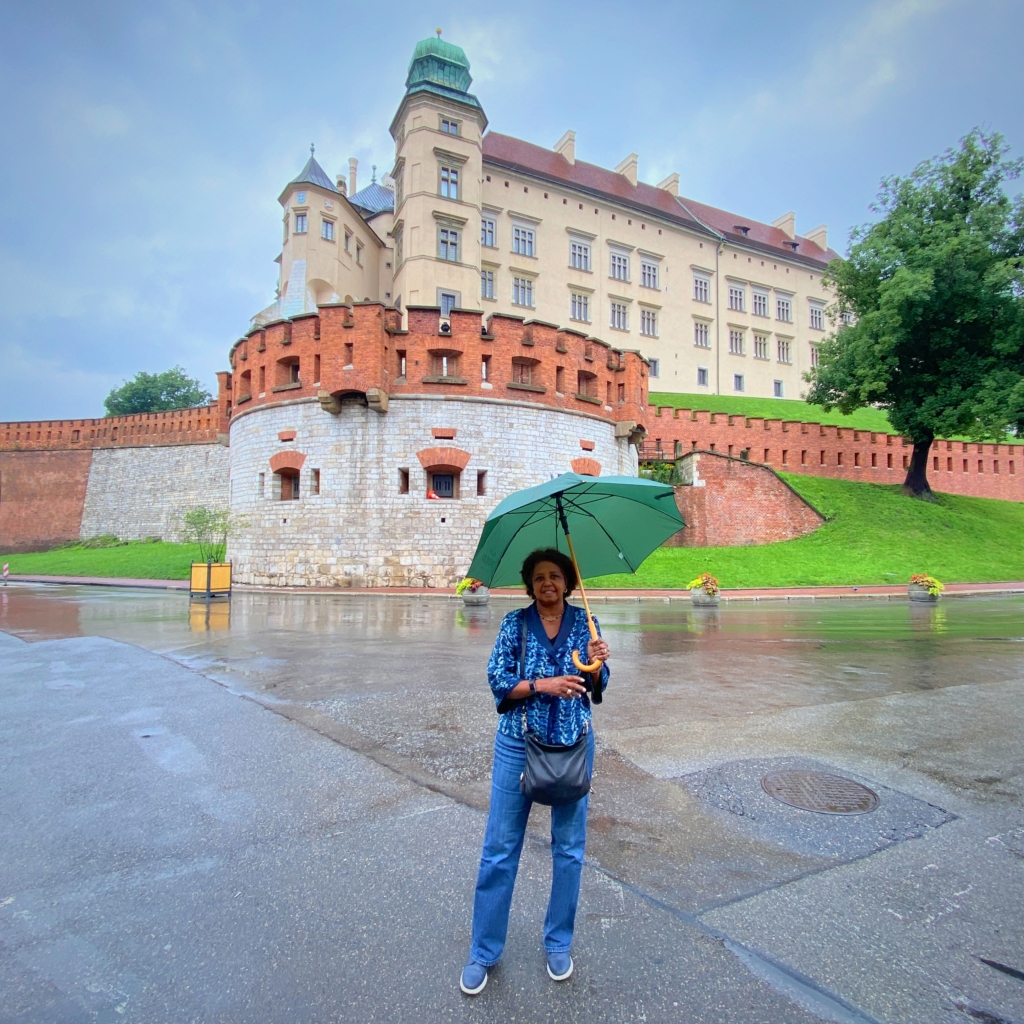
There is so much to see, including the cathedral, national treasury and medieval armor collection, that you could easily spend a day or two.
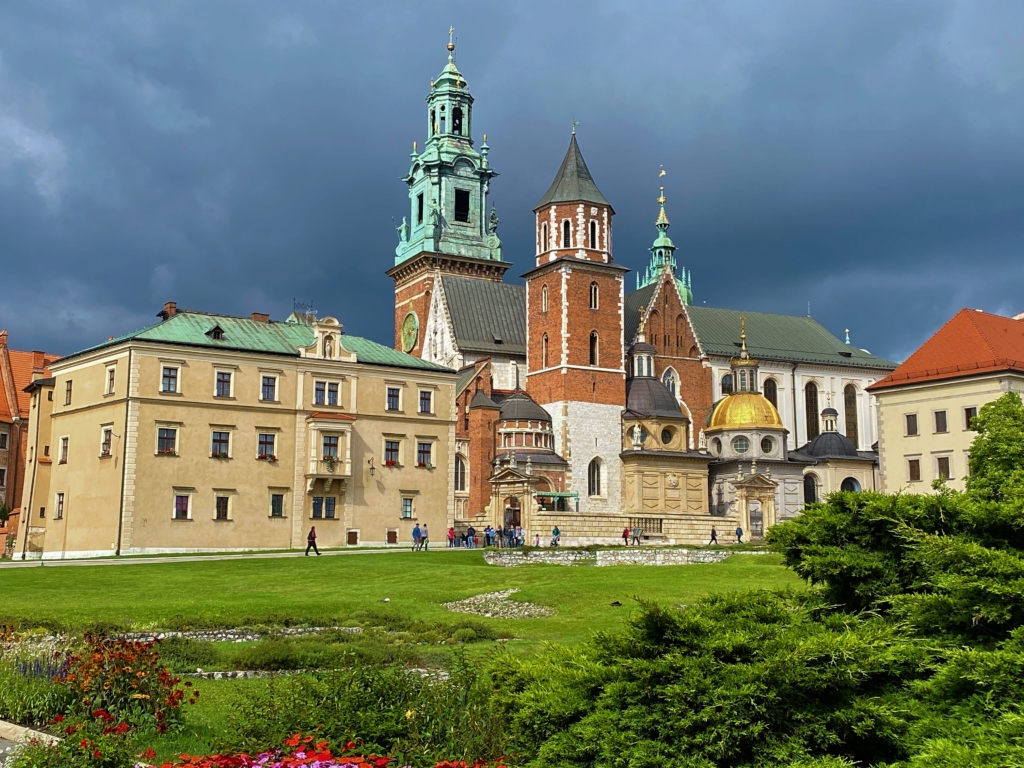
The one thing that no one should miss when visiting Kraków is the 16th century Belgian Tapestry collection. It consists of 137 pieces of Polish historical symbols, biblical scenes and particularly fanciful landscapes with mystical animals.
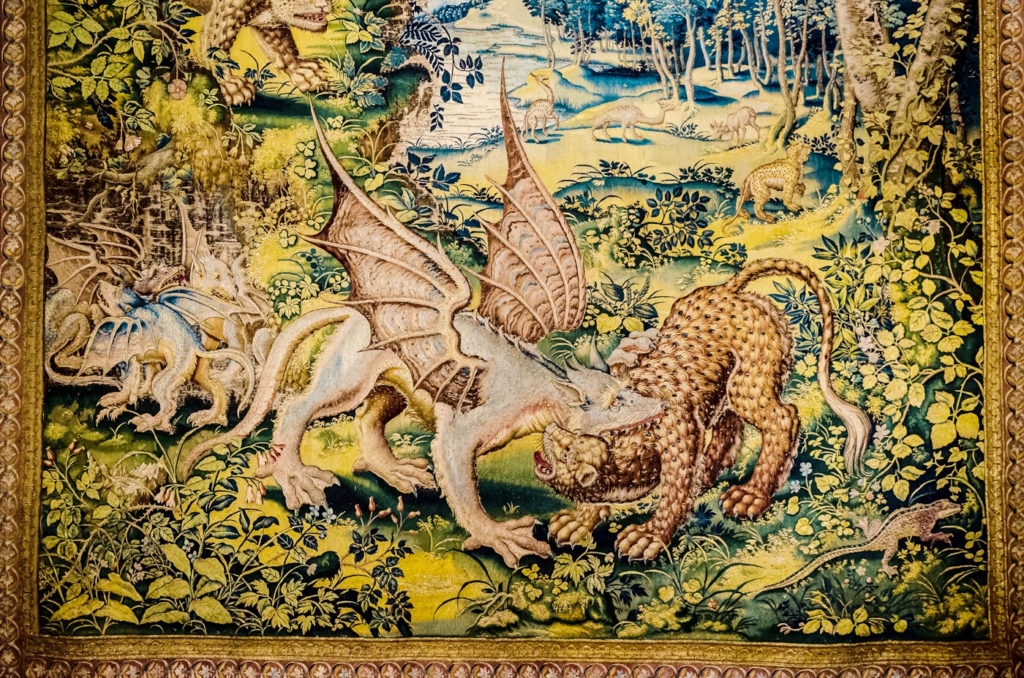
By the river, is the bronze statue of the Wawel Dragon on a limestone rock. It’s hugely popular with tourists as it breathes fire at least every five minutes (or sooner if an SMS is sent).
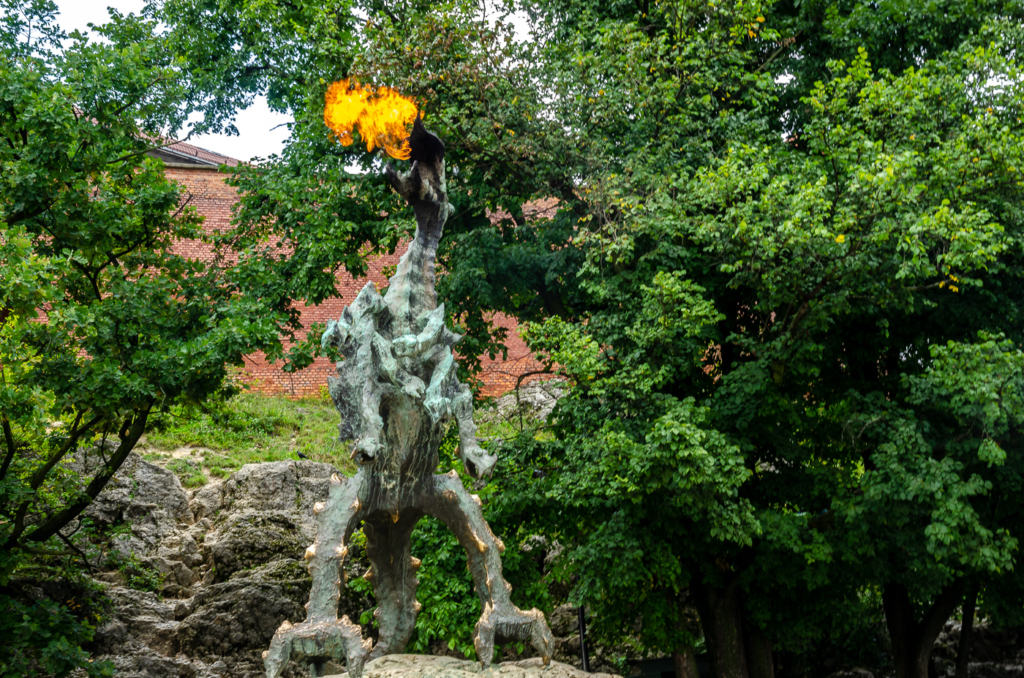
You can also see the Dragon’s Den for a small admission, which is uneventful but does lead out to the statue.
Barbican and St. Florian Street
Kraków was once surrounded by a defensive wall and the Barbican was the main entrance. It’s the most preserved one in Europe and a common meeting point for walking tours. Normally, the inside is open from April to October, but was closed when we were there.
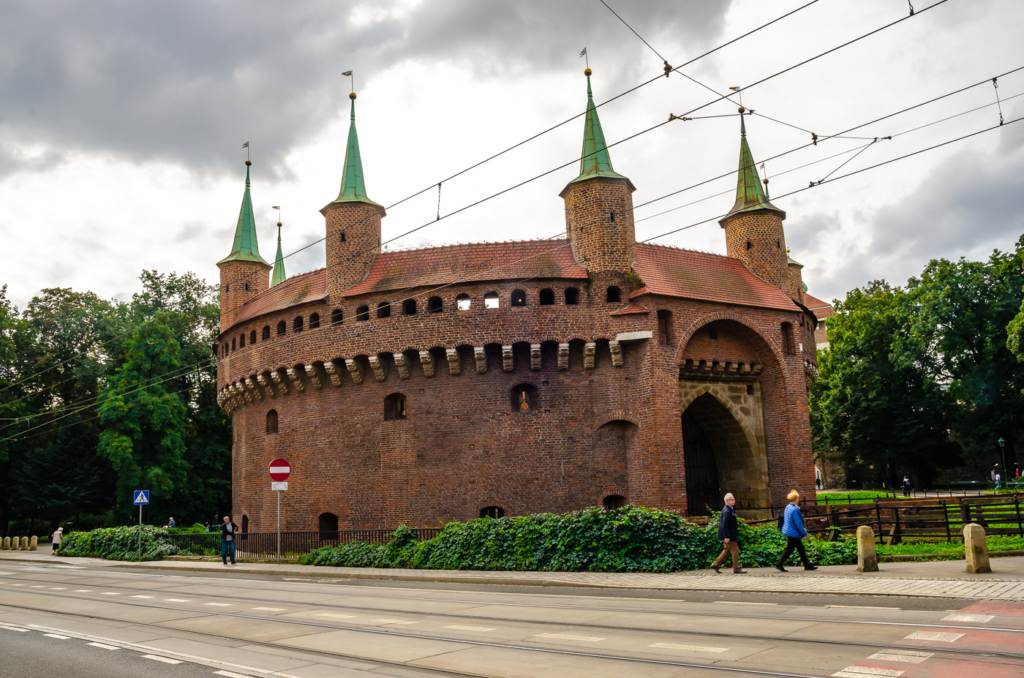
The Barbican was connected to the St. Florian Gate via a drawbridge, now by a cobblestone path. The gate is a rectangular Gothic tower and was another part of the city fortification.
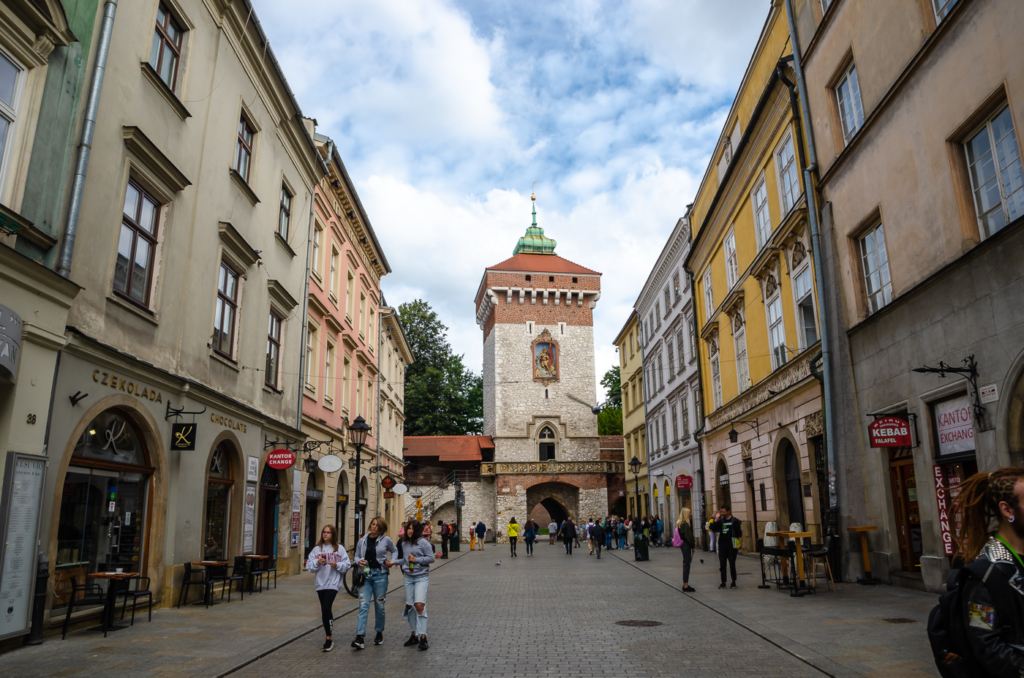
Underneath the gate is a model of the medieval streets under a 1257 charter based on the Magdeburg Law which regulated urban planning (this is an interesting topic for history buffs).
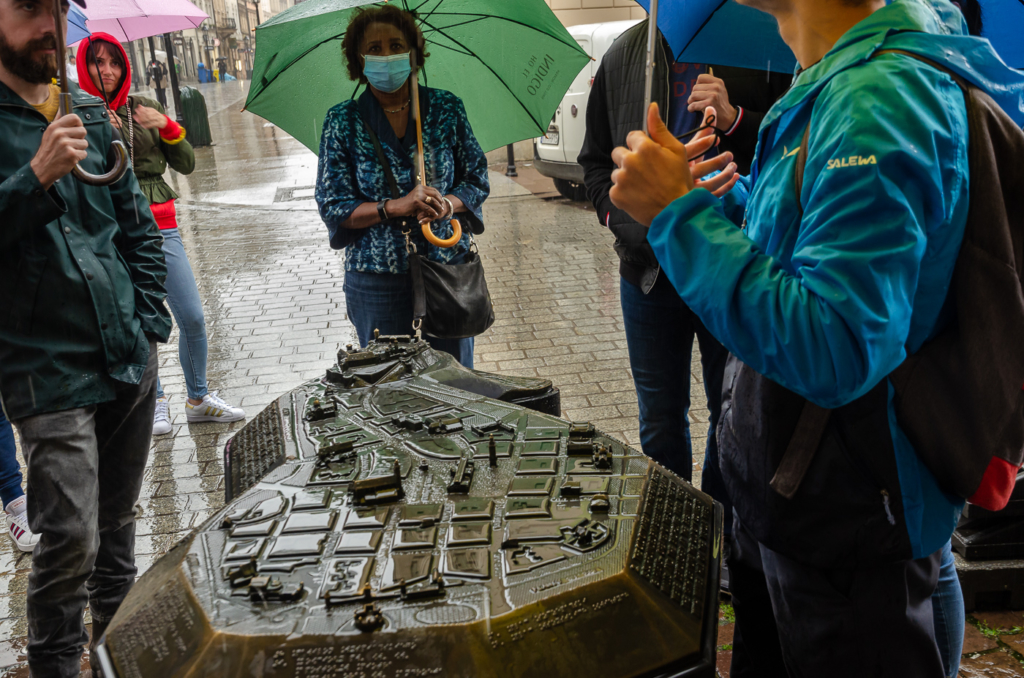
While we were on St. Florian Street, which starts from the Gate, we saw Kraków students in uniform. They looked happy, maybe because they haven’t started studying yet.
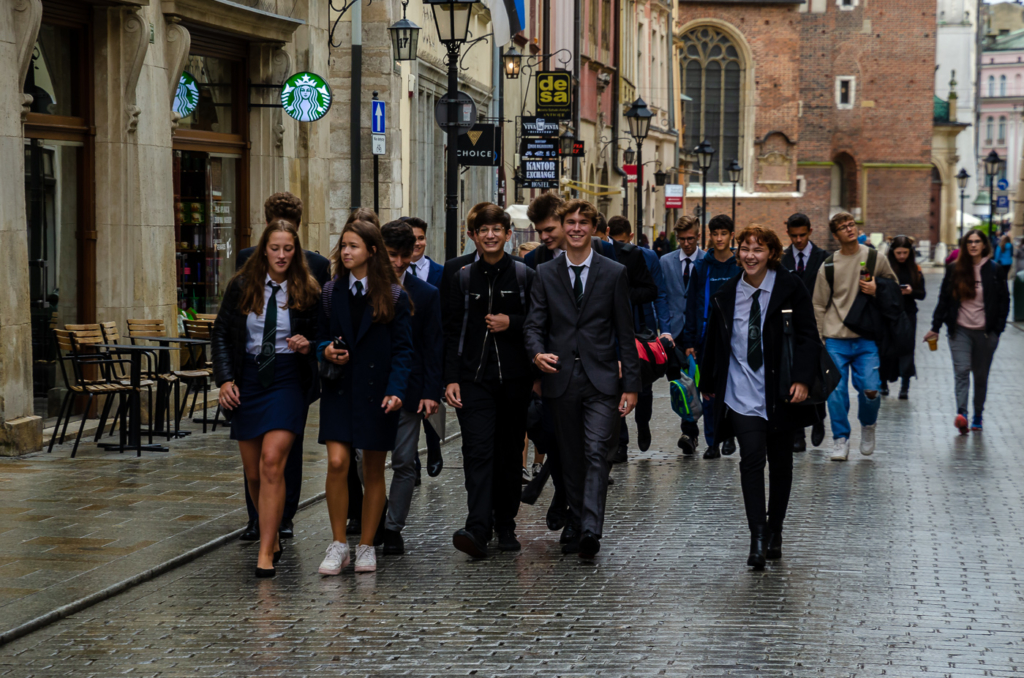
Kraków has over 150,000 college students from September to July, but they hadn’t yet converged on the city and may be fewer this year because of Covid.
Kazimierz (Jewish Quarter)
Kazimierz, formally established in 1335, was an independent town bordering Kraków. By the end of the 15th century, it became home to Jews who were being expelled from Kraków. In the mid-17th century, invasions, floods, famine and anti-Jewish riots decimated the town into a crumbling shadow of its former self. In 1800 Kazimierz, then under Austrian control, was incorporated into Kraków and rebuilt. Austria mandated all of Kraków’s Jews resettle here and eventually the population exceeded 60,000 between WWI and WWII. When the Nazis took over, the population was moved either to camps or to the ghetto across the river in Podgórze. With this history, it’s obvious why this is known as the Jewish Quarter.
Szeroka Street
This is the historic heart of Kazimierz and is really a square rather than a street. There are Jewish references everywhere you look: Jewish restaurants with metal menorahs…
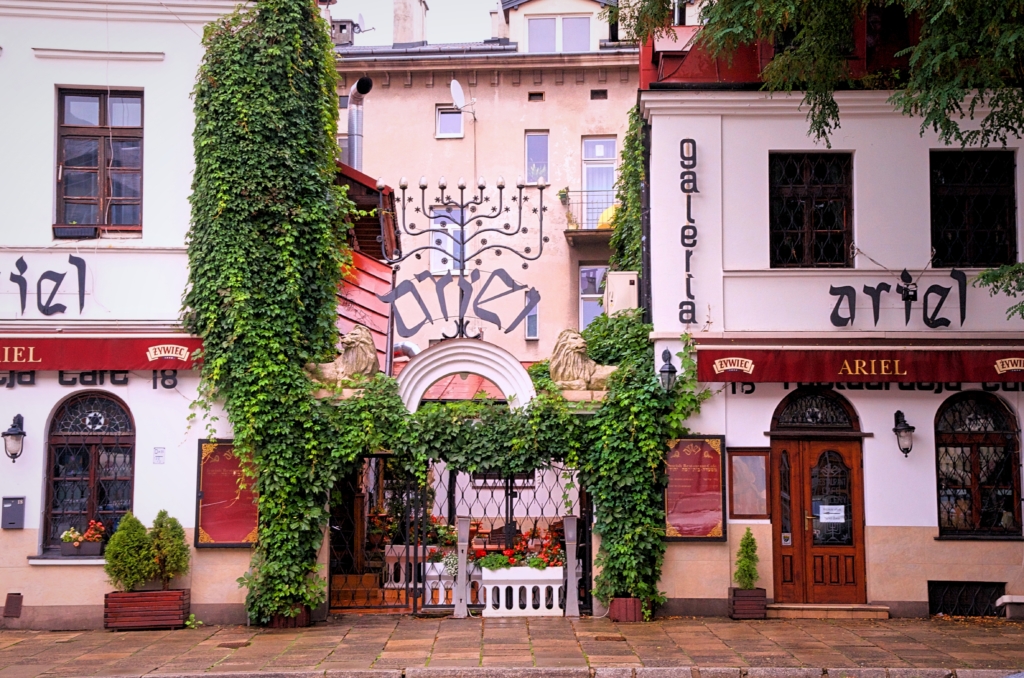
…and references to famous residents, such as the cosmetics entrepreneur Helena Rubinstein.
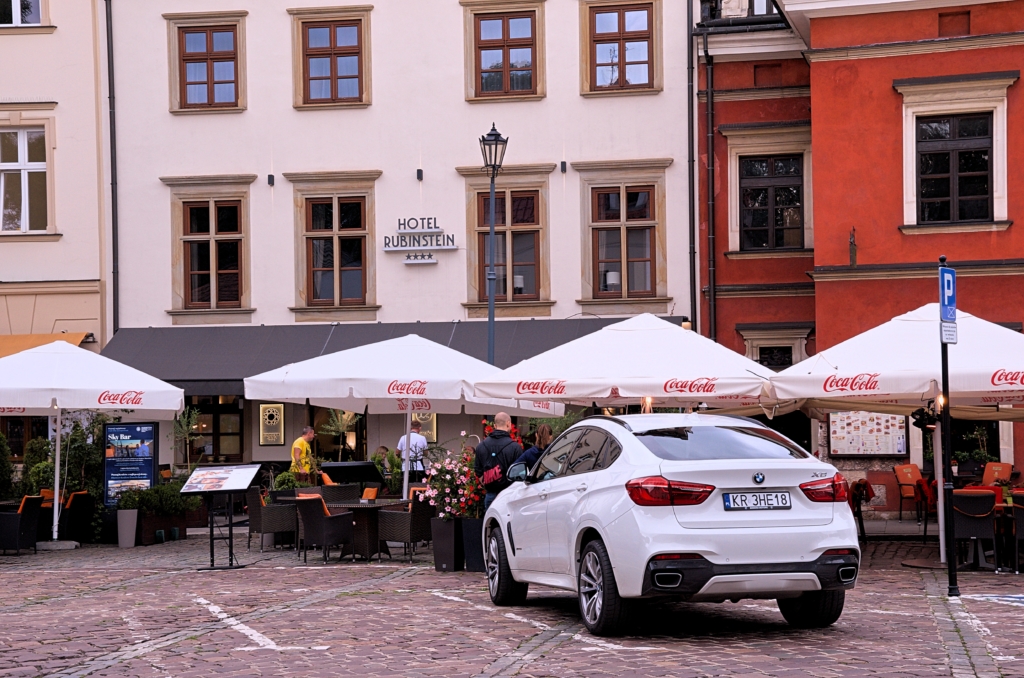
Most moving to me was the memorial to Jan Karski, a member of the Polish underground army, who warned the world for years about the Holocaust.
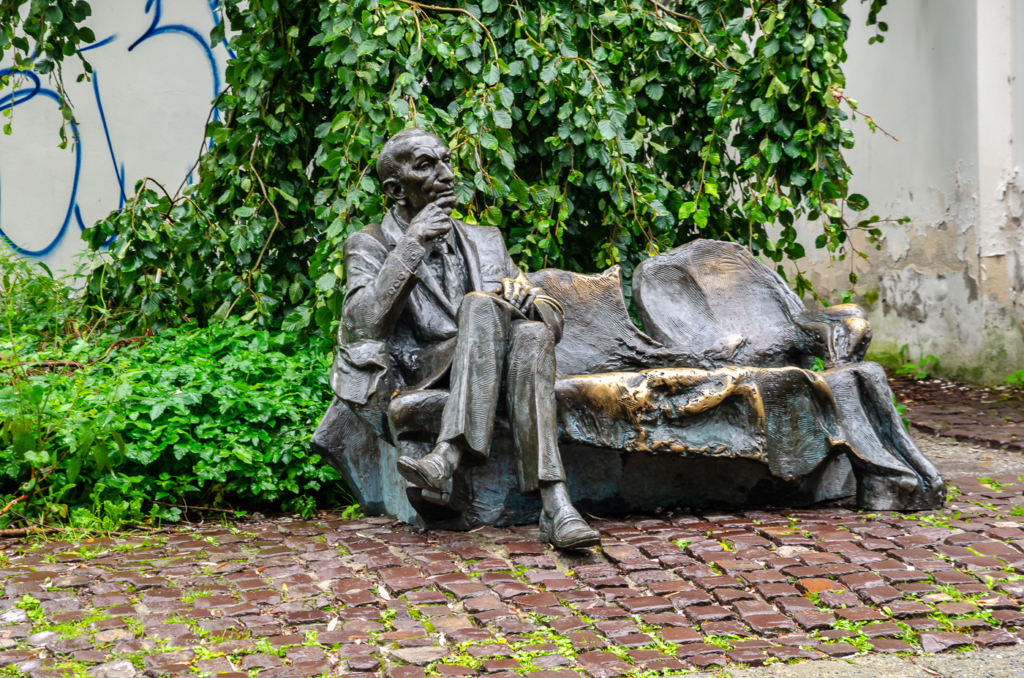
During WWII, he dangerously entered the Warsaw Ghetto and Nazi concentration camps in order to record the horrific crimes against Jews. In 1942 he met with many Allied leaders, including US President Franklin Roosevelt to warn them about the Nazi’s actions, but to no avail. After the war, he taught at Georgetown University in Washington DC for 40 years.
Galicia Jewish Museum
The Galicia Jewish Museum celebrates the Jewish culture of Polish Galicia, an area of southeast Poland and western Ukraine.
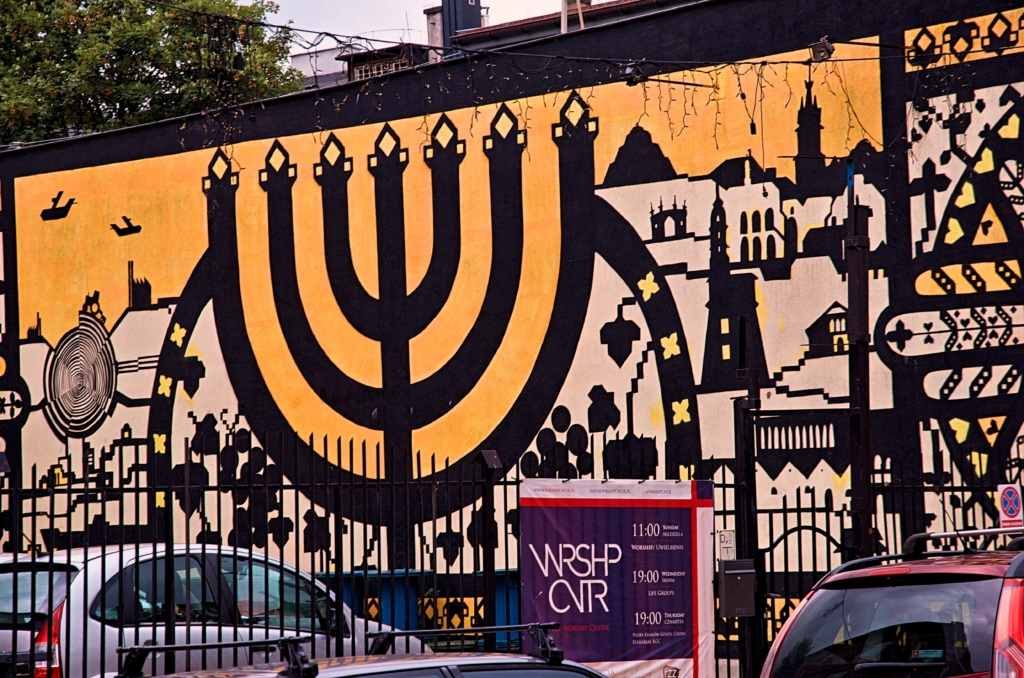
It has an interesting and unique view on Jewish history and is worth stopping in.
Eat, Drink and Be Merry in Kazimierz
If you are looking for the hipster vibe, this is the place.
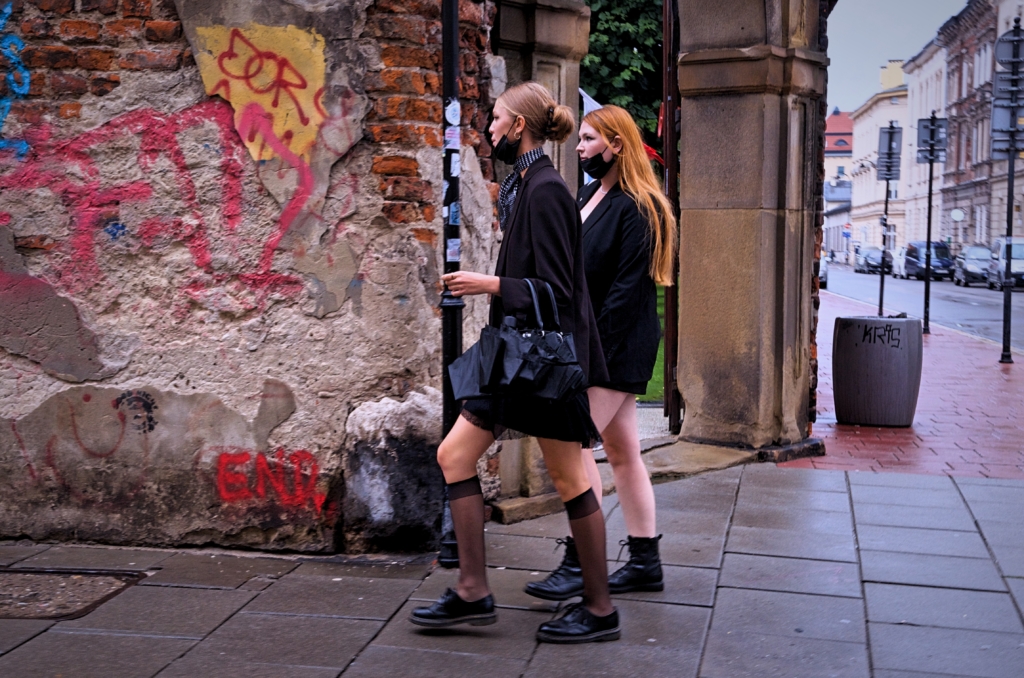
It has many trendy restaurants, offbeat bars, vintage clothing stores, all-day-and-night cafes and even interesting liquor stores.
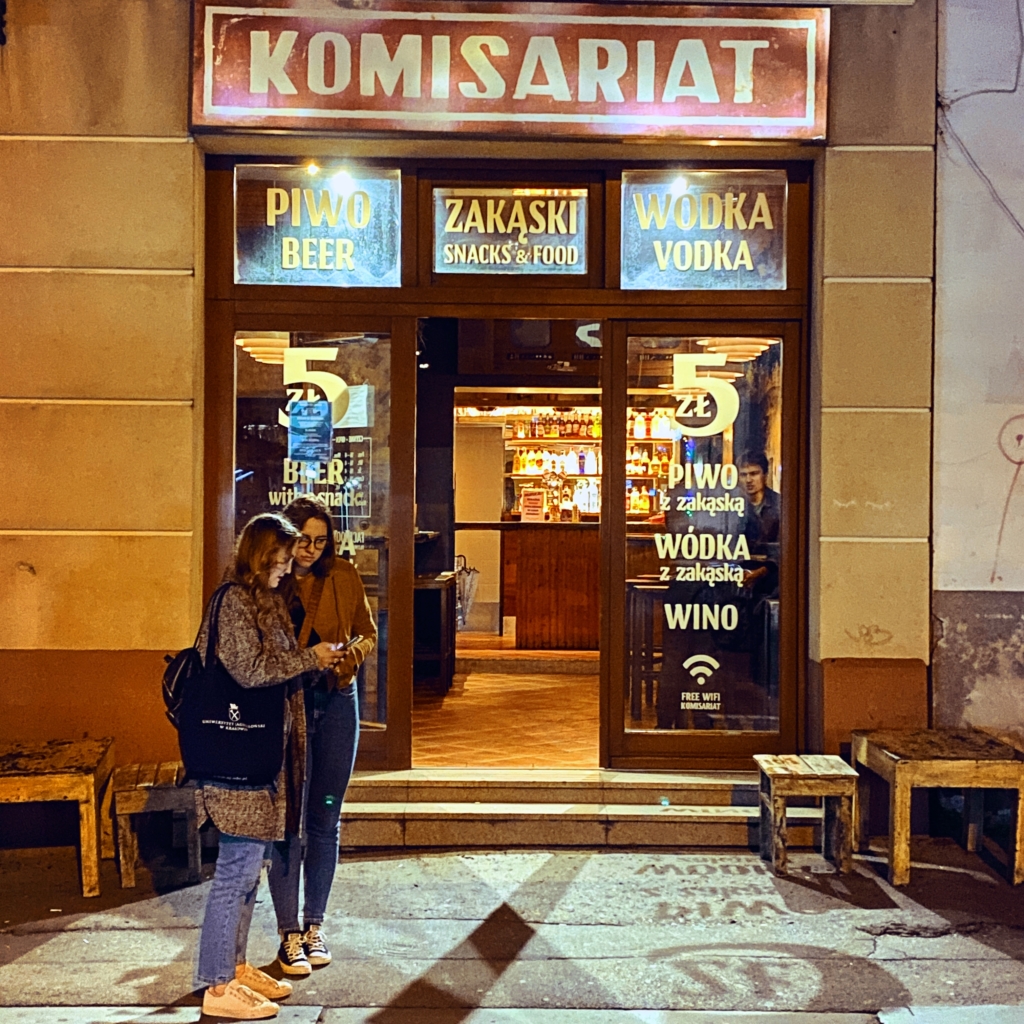
Like any self-respecting bohemian neighborhood, it has some awesome street murals, including this by Piotr Janowczyk on Józefa Street.
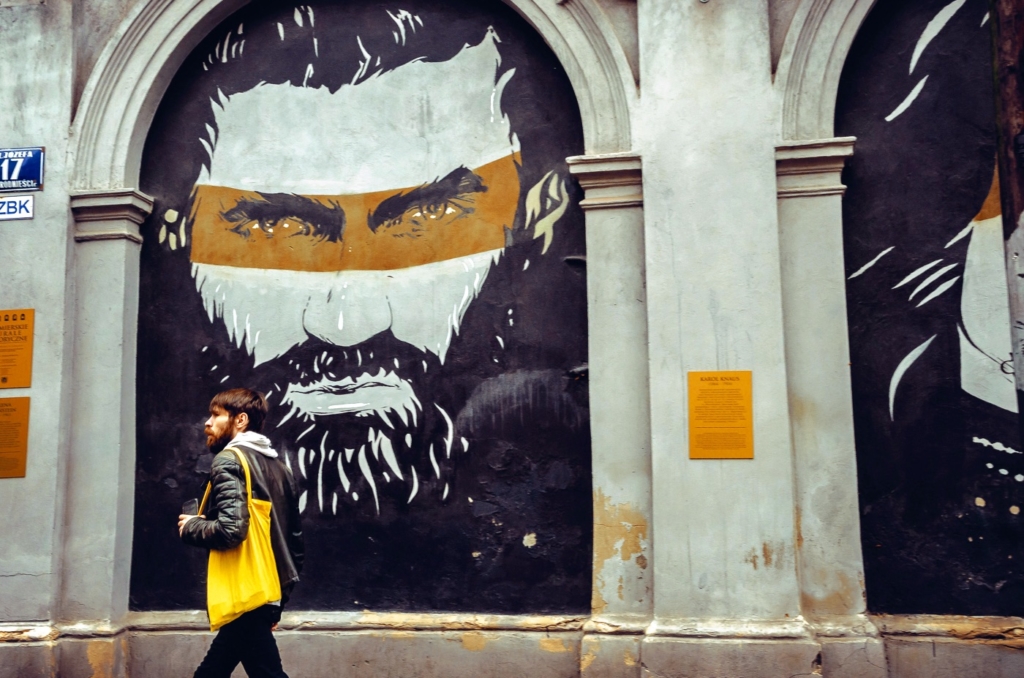
Podógrze
This is a large district across the Vistula River from Kazimierz with many areas of natural beauty. Podgórze means “foothills.” In my opinion, St. Joseph’s Church (picture at the top of the post) is the most scenic view in Kraków. The bridges crossing the river are interesting, including the Father Bernatek Footbridge with the gravity-defying creations by Polish sculptor Jerzy Kędziora (displayed below in black and white).
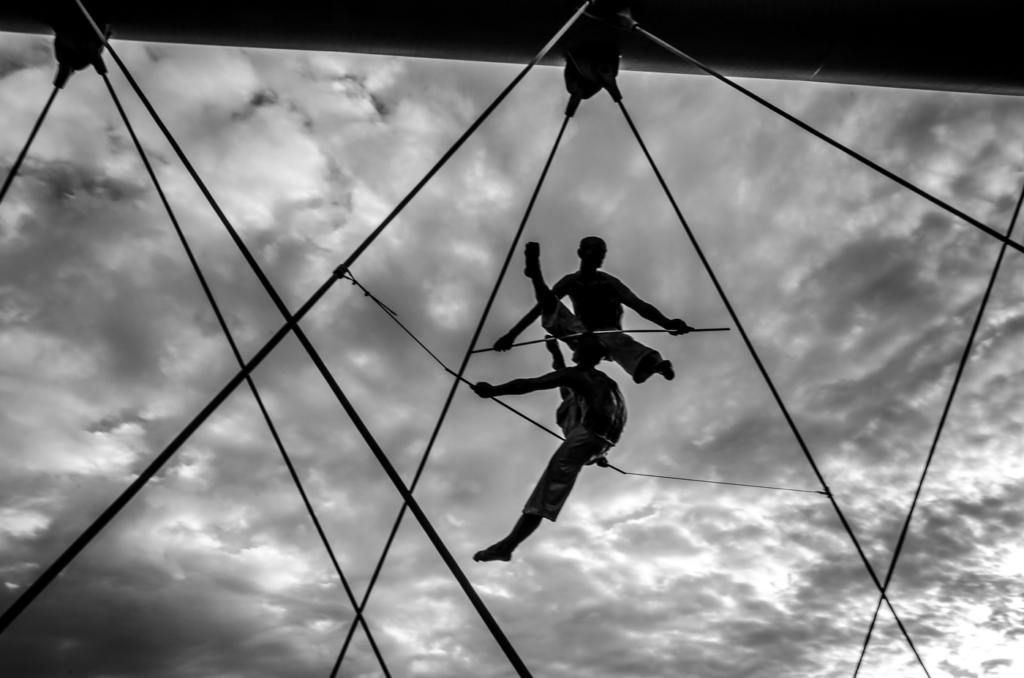
Jewish Ghetto
In September 1939, Nazis entered Kraków and immediately began persecuting the Jewish population. They made Jews wear Star of David armbands, confiscated their property and belongings and closed all synagogues. In 1941, they forced the remaining 3,000 Jews who hadn’t been shipped away or allowed to emigrate to the newly designated ghetto in Podgórze. It was one of five major, metropolitan Jewish ghettos in Poland under the Nazis. Four families were forced to live in one small apartment and many were homeless. Windows to the “Aryan” side were bricked up. The area was surrounded by a wall, a remnant still exists with a memorial plaque in Hebrew and Polish.
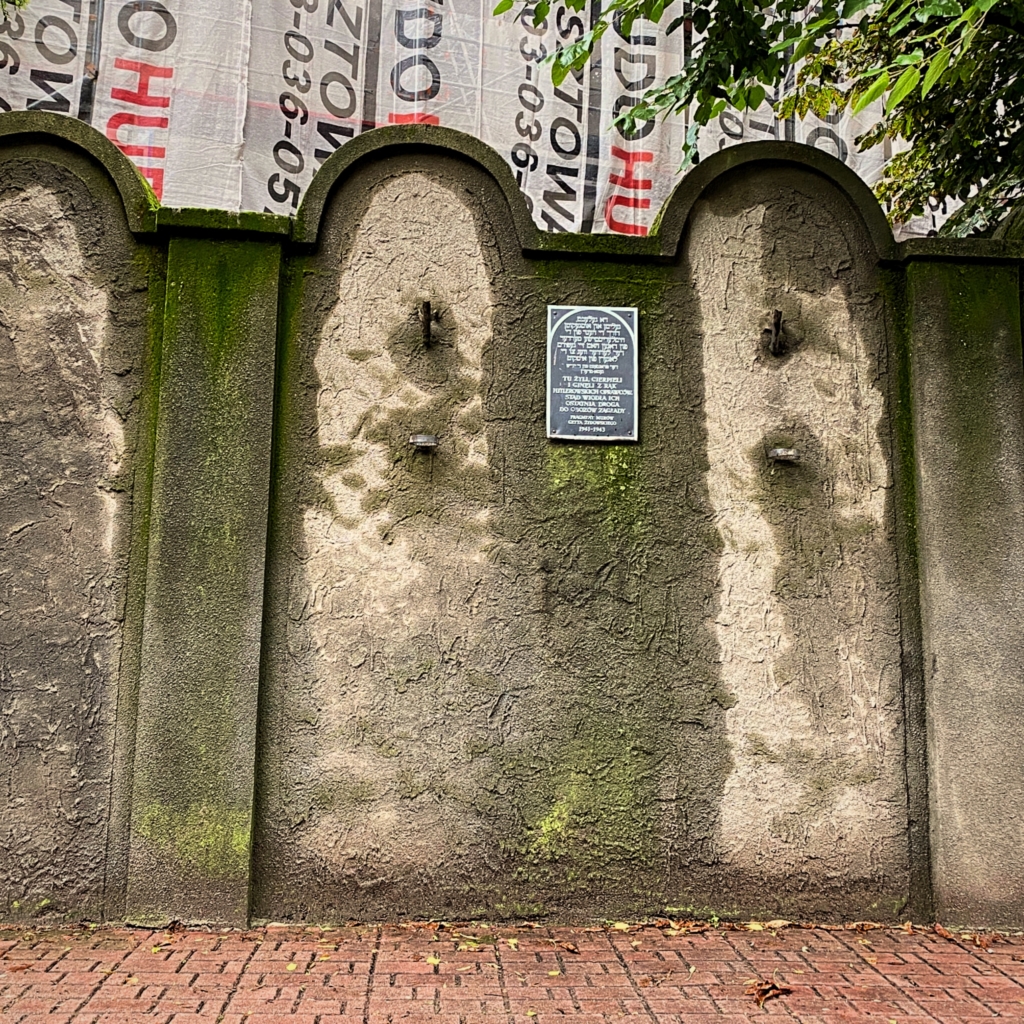
Zgody Square (aka Ghetto Heroes Square) is a memorial consisting of different-sized, iron chairs for victims of the Holocaust. It was inspired by descriptions of abandoned furniture and personal belongings dispersed around the square when it was “liquidated.” This involved the Nazis relocating those who could work to a concentration camp and killing about 2,000 in the streets and in their homes.
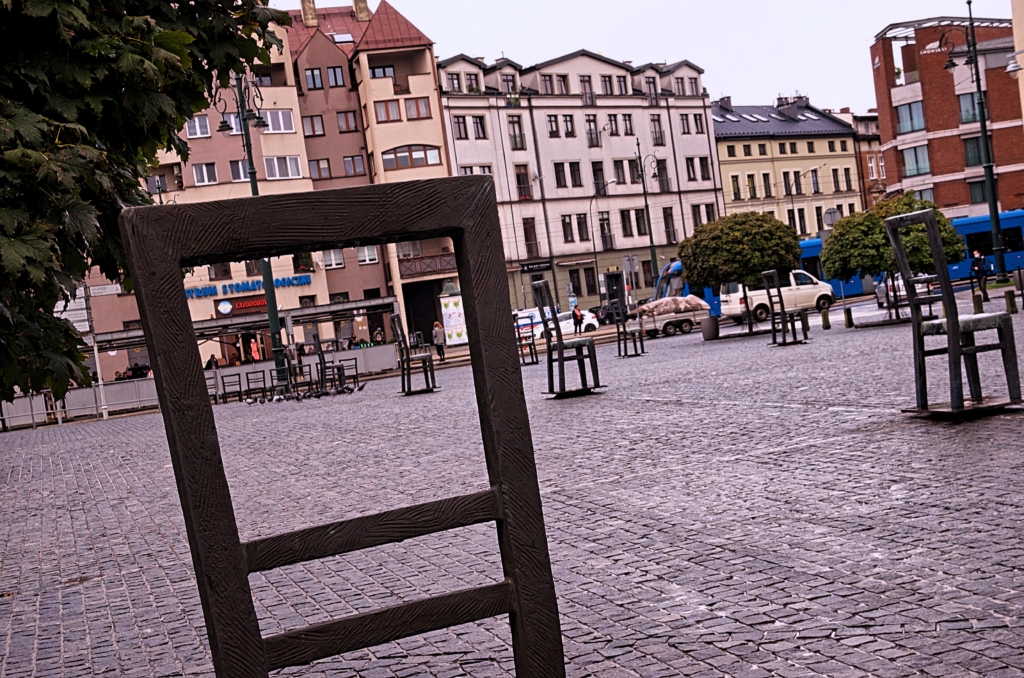
Oskar Schindler's Enamel Factory
Oskar Schindler (1908-1974) was a German entrepreneur and a member of the Nazi party who saved about 1200 Jews by employing them in his factories, one in Kraków.
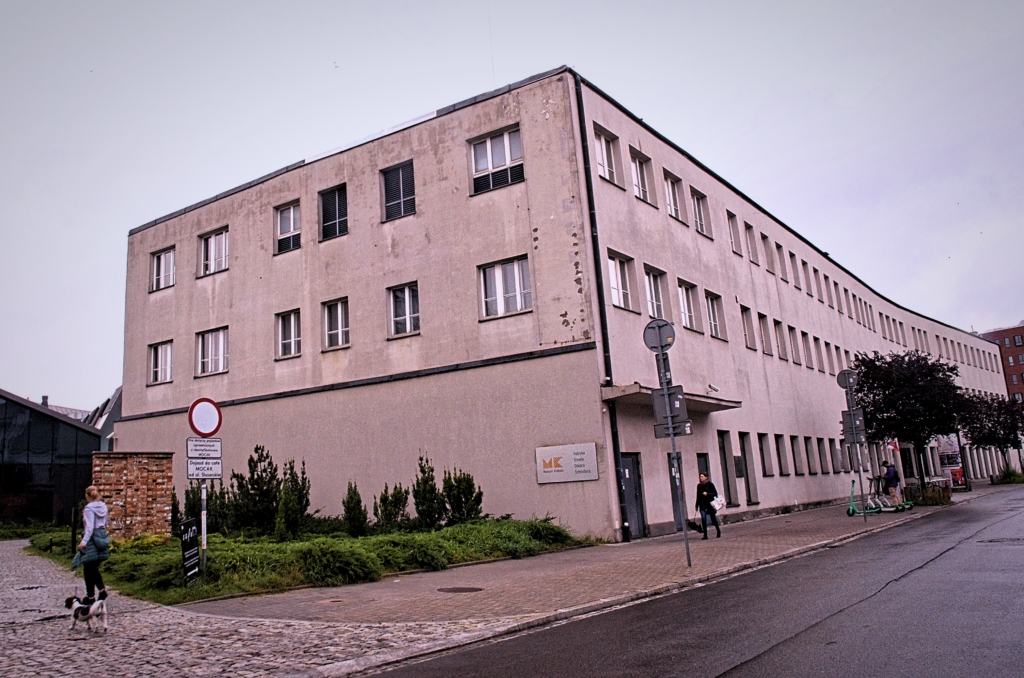
The factory has a small exhibit entitled Kraków under Nazi Occupation 1939-1945. We felt seeing the building was enough for us, especially after watching his story in “Schindler’s List”.
Wieliczka Salt Mine
This UNESCO World Heritage Site is a short drive or bus ride from the center of Kraków and was a working salt mine until 2007. From the beginning of operations in the 13th century, workers and artists decorated the mine with statues and embellishments.
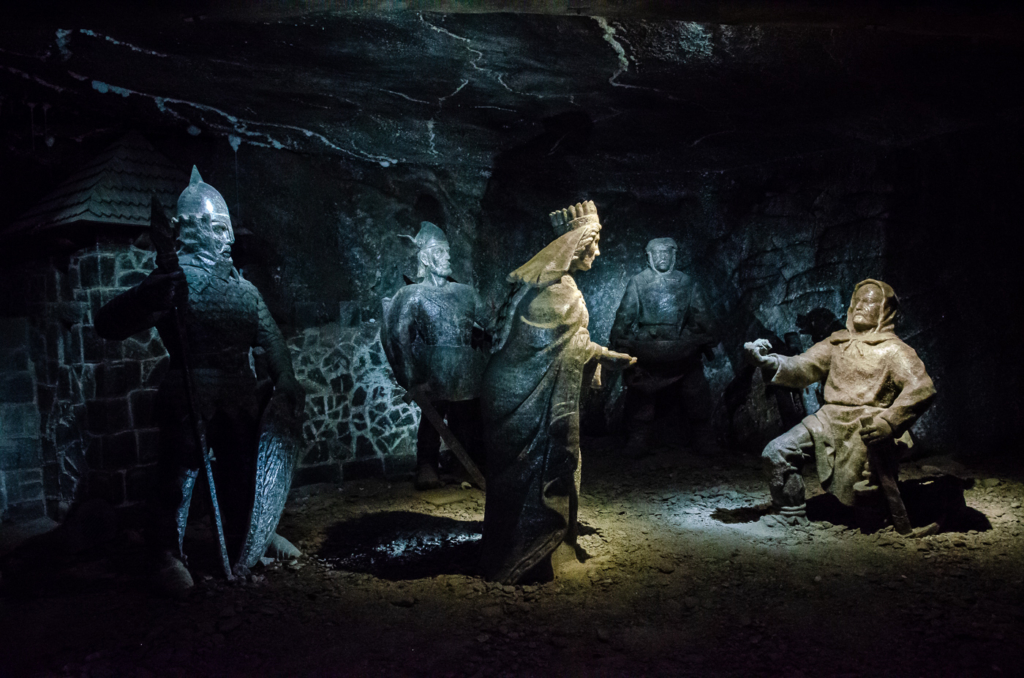
Now you can take a labyrinthine tour and see the historic and contemporary artwork, chapels and an underground lake. It even has event halls and restaurants. One of the highlights is St. Kinga’s Chapel.
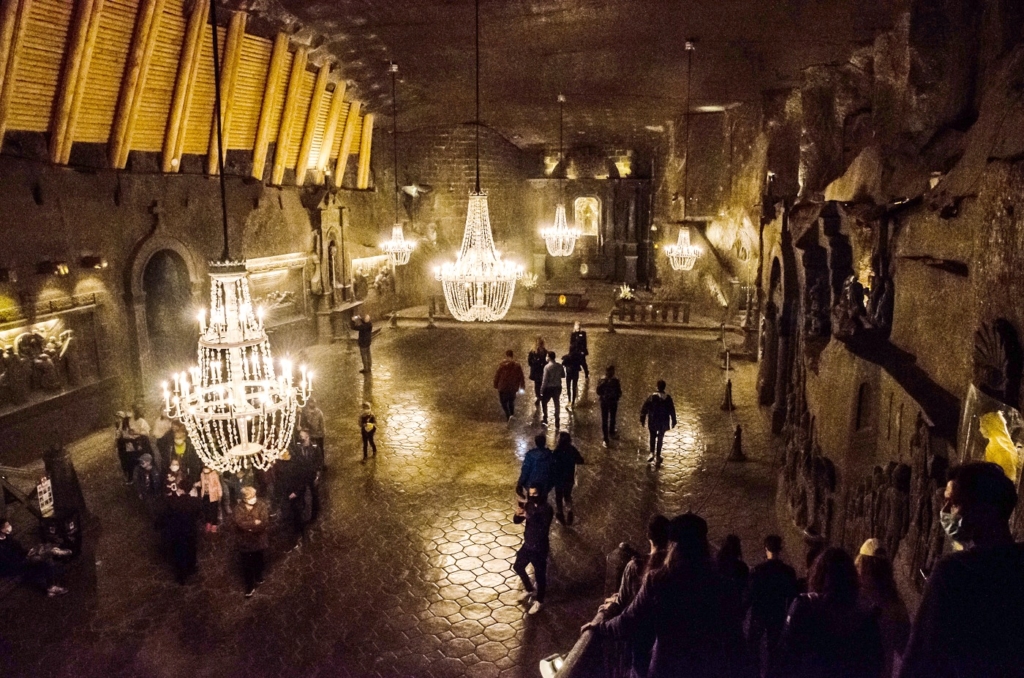
This is a very popular attraction, as long as you don’t mind being 135m/450ft underground for a couple of hours, walking 3.5km/2.2mi in a moist 18°C/64°F temperature.
Final Thoughts
We saw many of the highlights of Kraków, but just scratched the surface of what it offers. It definitely merits another trip when in the region.
I will always associate the city with Pope John Paul II (given name is Karol Wojtyla) who had lived there for four decades until he became Pope. His image is everywhere in Poland but particularly in Kraków, including this one on Bishop’s Palace in the Old Town.
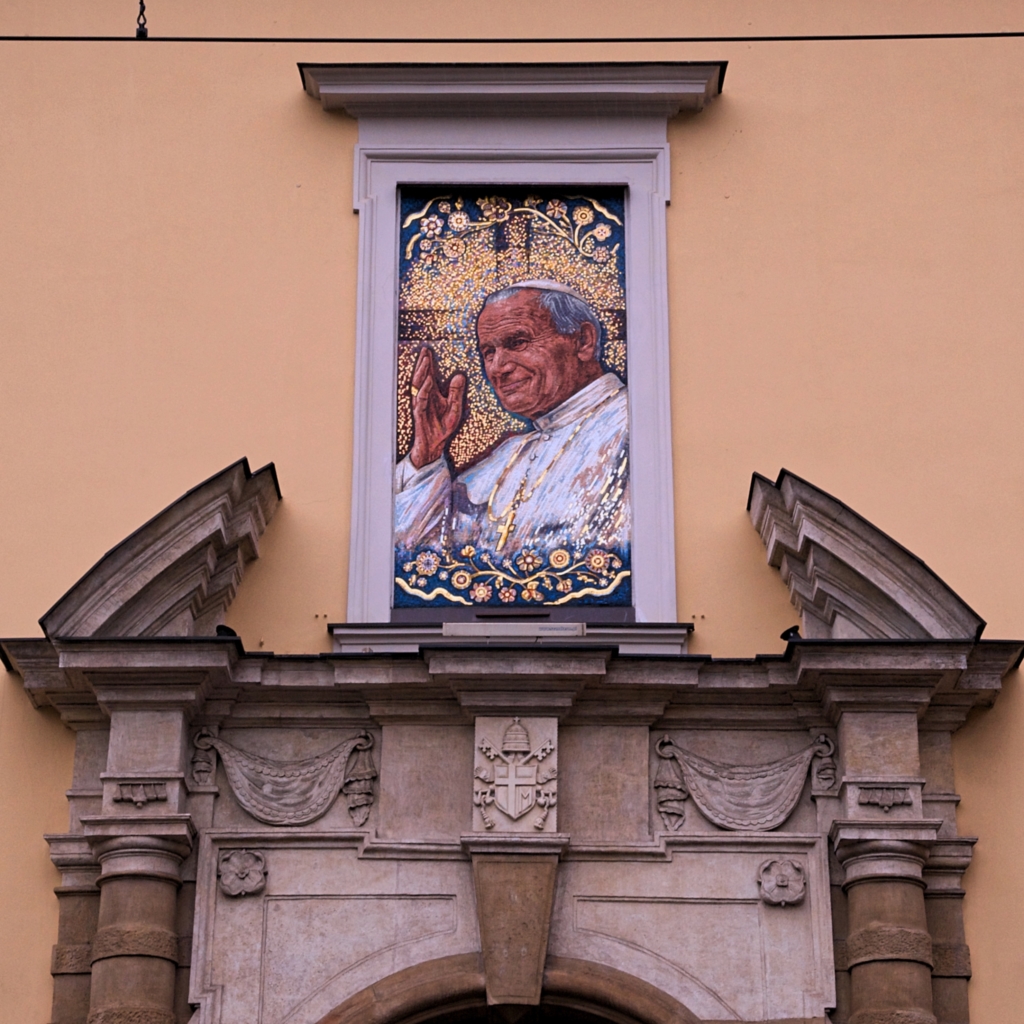
He was a humanitarian and an inspiration to millions, able to relate to the poor and rich alike, fluently in eight languages. Based upon our week of travel and my study of Polish history and arts, I believe he wasn’t an anomaly for the Polish people, but a reflection of the richness of their culture.

